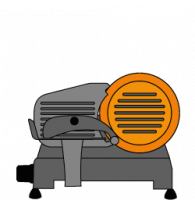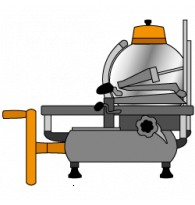How to use a slicer?
The operation of a slicer is based on a simple yet effective mechanism, designed to ensure quick and uniform cuts. The main components of a slicer include the rotating blade, the sliding carriage, and the adjustment controls, which together allow for safe and precise use.
Here are the main steps of operation:
- Preparation of the product to be sliced: the food is placed on the sliding carriage and secured with a support or clamp to ensure stability during cutting.
- Adjustment of cutting thickness: using a knob, the desired slice thickness can be selected, usually ranging from a few millimetres to several centimetres, depending on the model.
- Blade activation: in electric slicers, the blade is set in motion by a motor, ensuring stable and continuous rotation. In manual slicers, the blade movement is driven by a flywheel or crank.
- Carriage movement: the operator slides the carriage towards the blade, which penetrates the food, cutting it precisely. The movement can be automatic in more advanced models or manual in traditional ones.
- Collection of sliced pieces: the slices fall onto a tray placed under the blade or can be collected directly by the operator, ready to be served or packaged.
Distinctive components of slicers
- Rotating blade: the heart of the device, available in various diameters, made from materials such as stainless or tempered steel for resistance and durability.
- Inclined or vertical carriage: facilitates the positioning of the product and its sliding towards the blade. Inclined carriages are more suitable for foods that benefit from gravity to aid cutting.
- Adjustment system: allows for precise selection of slice thickness, ensuring uniformity even in repetitive operations.
Maintenance of a slicer
To use a slicer correctly, it is important to follow some guidelines:
- Cleaning before and after use: remove any food residues from the blade and other components using suitable detergents.
- Blade sharpening: keeping the blade sharp ensures optimal performance and reduces the effort of the motor or flywheel.
- Lubrication of moving parts: apply food-grade lubricants to ensure smooth carriage movement and long-lasting components.
What are the advantages of slicers?
Slicers offer a range of advantages that make them an indispensable tool both in the kitchen and in professional settings. Compared to other manual cutting methods or the use of knives, these machines ensure superior precision, faster work speed, and versatility that makes them suitable for different types of food.
- Uniform and adjustable cutting: thanks to the thickness adjustment system, perfectly equal slices can be obtained, essential for preparing professionally presented dishes.
- Efficiency and speed: the motorized or manual mechanism of slicers allows for the rapid slicing of large volumes of food.
- Reduction of fatigue: the operator only needs to guide the product towards the blade, letting the machine do the most demanding part of the work.
- Suitable for different foods: slicers can be used to cut a wide range of food products, including cured meats, cheeses, bread, and much more.
- Efficiency for large volumes: professional models, equipped with powerful motors and large blades, are designed for intensive use, ensuring high performance without interruptions.
- Ease of use: even the most advanced models are designed to be intuitive, with simple controls and integrated safety systems to reduce risks.
- Ergonomic and compact design: modern slicers, especially domestic ones, are designed to take up little space in the kitchen while maintaining high functionality.
Types of slicers
A wide range of slicer models is available, designed to meet the needs of different users, from domestic to food industry professionals. Here is an overview of the main categories of slicers:
- Slicers with a 170 mm blade: compact and suitable for domestic use, perfect for small cuts and environments with limited space.
- Slicers with 190, 195, and 200 mm blades: versatile and ideal for mixed domestic and semi-professional use.
- Slicers with a 220 mm blade: designed for those who need to cut larger foods, suitable for both home and small businesses.
- Slicers with a 250 mm blade: a semi-professional option that ensures precise cuts even in intensive contexts.
- Slicers with a 275 mm blade: robust and high-performing, perfect for delicatessens and restaurants.
- Slicers with a 300 mm blade: indicated for professional use, capable of cutting large quantities of food in a short time.
- Professional electric CE slicers: ideal for regulated work environments, ensuring high performance and compliance with regulations.
- Flywheel slicers: elegant and precise, optimal for those seeking a quality product with a refined design.
Small slicer with a 170 mm blade
Small slicers with a 170 mm blade are the most compact available on the market, primarily designed for domestic use. These models are ideal for those with limited kitchen space but who do not want to give up the convenience of a slicer. Thanks to their reduced size, they are easy to store and simple to use.
- Compactness: these machines take up very little space, making them suitable even for the smallest kitchens.
- Domestic use: perfect for slicing cured meats, cheeses, and bread in small quantities.
- Ease of cleaning: components easily disassembled for quick and effective cleaning.
Slicer with 190, 195, and 200 mm blades
This category includes more versatile models, suitable for both domestic and semi-professional use. The slightly larger blades allow for the cutting of larger foods than the 170 mm models, making them an ideal solution for those seeking greater flexibility.
- Versatility: suitable for different types of food, such as cured meats, aged cheeses, and bread.
- Robustness: built with durable materials to ensure longevity and reliability.
- Thickness adjustment: ability to obtain precise and uniform cuts, from very thin to thicker.
Slicer with a 220 mm blade
Slicers with a 220 mm blade are designed for those who need a more robust and high-performing device than previous models. These models are particularly suitable for frequent use and for working with larger foods, such as whole hams or large aged cheeses.
- More powerful motors: ensure consistent performance even with harder or bulkier foods.
- Ergonomic design: facilitate prolonged use thanks to a stable and well-balanced structure.
- Easy cleaning: removable components for simple and quick maintenance.
Slicer with a 250 mm blade
Slicers with a 250 mm blade represent a significant step towards the professional realm. These models are designed to meet the needs of those who require a versatile and powerful device, capable of working with precision even in intensive contexts. Ideal for delicatessens, restaurants, and frequent home use, they ensure high performance.
- Large blade diameter: allows working on larger foods, such as whole hams or bulky aged cheeses.
- Robust motor: ensures consistent performance even with harder foods and resistance to prolonged use.
- Stable and resistant structure: often made from materials such as steel or anodized aluminium, to ensure durability and resistance to corrosion.
- Facilitated cleaning: many models include removable components, such as the carriage and blade cover, for quick and thorough cleaning.
Slicer with a 275 mm blade
Slicers with a 275 mm blade are ideal for those seeking a robust and high-performing machine, capable of working precisely on a wide variety of foods. These models fall into the professional range and are designed to withstand frequent and intensive use, maintaining high-quality standards.
- Precise and uniform cutting: the 275 mm blade allows slicing larger products with extreme precision.
- Powerful motor: designed for prolonged use without the risk of overheating, ideal for professional contexts such as delicatessens and restaurants.
- High-quality components: made from corrosion-resistant and easy-to-clean materials, such as stainless steel or anodized aluminium.
- Integrated safety system: essential to ensure safe use even in high-paced work environments.
Slicer with a 300 mm blade
Slicers with a 300 mm blade are designed for the professional and industrial sector. With a large diameter blade and a powerful motor, these models can handle very high workloads, always ensuring maximum precision. They are suitable for cutting large-sized products, such as whole hams, aged cheeses, or large-format bread.
- Professional performance: the high-power motor and 300 mm blade allow working with speed and efficiency.
- Robust and durable structure: made from materials such as stainless steel or anodized aluminium, to resist wear and corrosion.
- Ergonomic design: designed to ensure ease of use and comfort even during prolonged use.
- Simple cleaning and maintenance: many models are equipped with removable plates and carriages, simplifying cleaning and ensuring hygiene.
Professional electric slicer with CE certification
CE professional electric slicers are designed to comply with European safety and quality standards, ensuring high performance in work environments. These models are equipped with powerful motors, large blades, and technical features that make them indispensable in contexts such as delicatessens, supermarkets, and restaurants.
- CE certification: ensures that the machine complies with European safety standards, ideal for professional contexts.
- High-performance motor: designed for continuous use without interruptions, with high power and reliability.
- Resistant and precise blades: available in various diameters, ensuring clean and uniform cuts even with difficult foods.
- Advanced safety systems: include blade guards and quick-stop devices to ensure safe use.
Flywheel slicer
Flywheel slicers represent excellence in both aesthetics and functionality. These manually operated models are characterized by an elegant and retro design, making them ideal for high-quality delicatessens and for those seeking a refined machine that does not require electrical power.
- Classic design: the flywheel mechanism gives a vintage touch and a unique aesthetic, perfect for prestigious environments.
- Precision in cutting: the manual system allows total control over the blade speed, ideal for slicing cured meats and hams without altering their organoleptic properties.
- High-quality materials: often made from steel and other high-quality materials, ensuring resistance and durability.
- Independence from electricity: perfect for environments without access to the electrical grid or for those seeking an eco-friendly alternative.
Technical features of slicers
Slicers are devices designed with technical features that determine their functionality, durability, and adaptability to different usage contexts. On AgriEuro, it is possible to choose from a wide range of models filterable based on specific technical parameters, to easily find the slicer best suited to your needs. The main technical features include:
- Type: the design of the plane and carriage, which can be gravity, vertical, standard, or bridge, affects cutting efficiency.
- Power source: electric (single-phase or three-phase) or manual, to adapt to different environments and needs.
- Blade material: stainless or tempered steel, to ensure resistance and durability.
- Blade diameter: determines the ability to work with foods of different sizes.
- Cutting capacity: measured in height and width, indicates the maximum dimensions of the foods that can be processed.
- Base material: steel, aluminium, or glass, for resistance, aesthetics, and ease of cleaning.
- Certifications: ensure safety and compliance with regulatory standards.
- Sharpening system: integrated or removable sharpener, to keep the blade always efficient.
Cutting technology
The cutting technology of slicers directly affects their use and cutting efficiency, thanks to the arrangement of the blade and work surface. Here are the main types:
- Gravity slicer: have an inclined plane that uses gravity to facilitate cutting, particularly useful for heavier foods.
- Vertical slicer: equipped with a blade perpendicular to the plane, requiring more manual control, ideal for precise cuts.
- Standard slicer: classic and robust structure, suitable for multiple uses.
- Bridge slicer: allow placing a tray under the blade to easily collect sliced foods.
Power source
The power source of slicers affects their practicality and intended use:
- Single-phase electric: powered through a common power outlet, offers practicality and immediate start-up.
- Three-phase electric: powered with 400V current, designed for intensive and professional use.
- Manual flywheel: ideal for environments without electricity or for those seeking a traditional design.
- Manual crank: mechanically operated, a simple solution for limited uses.
Blade material
The blade material determines the quality of the cut and the machine's resistance:
- Tempered steel: offers good corrosion resistance and maintains sharpness over time, ideal for domestic use.
- Stainless steel: resists corrosion and chemicals, particularly suitable for professional environments and salty foods.
Blade diameter
The blade diameter establishes the slicer's ability to work with foods of various sizes:
- 170-200 mm: suitable for domestic use and small-sized foods.
- 220-250 mm: ideal for mixed domestic and semi-professional use.
- 275-320 mm: designed for professional or industrial environments, suitable for large volumes.
Cutting capacity
The cutting capacity indicates the maximum dimensions of the foods that can be processed, measured in height and width:
- Cutting height: defines how high the product to be sliced can be, for example, 120 mm.
- Cutting width: establishes the maximum width of the product to be processed, for example, 150 mm.
Base material
The base material affects the stability and ease of maintenance of the slicer:
- Painted steel: economical and resistant, suitable for occasional use.
- Anodized aluminium: lightweight, easy to clean, and corrosion-resistant.
- Shatterproof glass: adds a touch of elegance and is useful for supporting trays.
Certifications
Certifications ensure that the slicer meets safety standards:
- Domestic CE: for safe use at home.
- Professional CE: compliant with regulations for intensive use in work environments.
Sharpening system
A good sharpening system ensures that the blade maintains its efficiency over time:
- Not present: blade without an integrated sharpening system.
- Removable: sharpener can be purchased separately or removed for customized maintenance.
- Fixed: sharpener integrated into the machine, for greater convenience.
Guide to buying the best slicers
Choosing the slicer best suited to your needs requires the analysis of some fundamental aspects, such as the type of use, the size of the foods to be processed, and the technical features. Here is a guide to help you choose.
- Type of work to be done: choosing the slicer based on the type of use is essential. For domestic use and occasional cuts, compact models with blades from 170-220 mm and medium-power motors are recommended. For semi-professional uses, such as in small delicatessens or for frequent cutting, slicers with 250 mm blades and more powerful motors are ideal. In professional or industrial settings, it is necessary to opt for models with blades from 275-320 mm, robust motors, and CE certifications to ensure safety and high performance.
- Size and quantity of foods to be processed: the blade diameter determines the type of foods that can be sliced. Blades from 170-200 mm are perfect for small-sized foods such as cured meats, bread, and cheeses. Blades from 220-250 mm are suitable for medium-sized foods and semi-professional use. Blades from 275-320 mm are suitable for large volumes of work in professional or industrial contexts.
- Construction materials: the materials used for the construction of the slicer affect its durability and ease of maintenance. Plastic slicers are lightweight and manageable, ideal for limited domestic use. Anodized aluminium is corrosion-resistant, easy to clean, and suitable for frequent use. Stainless steel is the most robust and hygienic material, perfect for professional or industrial environments.
- Production needs: considering the technical features that influence productivity is essential. A powerful motor allows working with hard foods or large quantities without effort. An integrated sharpener keeps the blade efficient, ensuring always precise cuts. Advanced safety systems ensure safe use, particularly important in intensive contexts.
- Other factors to consider: to ensure ease of use and maintenance, it is preferable to choose models with removable components for quick and effective cleaning. CE certifications ensure that the slicer meets safety standards, indispensable for professional use. Design and colour can also make a difference, allowing the device to be integrated into the work environment or kitchen.
Who should buy a slicer?
- Hobbyists: hobbyists can benefit from compact and easy-to-use slicers. For limited use, models with blades from 170-200 mm are ideal, ensuring practicality and precision in occasional cuts.
- Cooking enthusiasts: cooking enthusiasts who want to improve the quality of their dishes can choose slicers with blades from 200-250 mm. These models offer a balance between practicality and performance, suitable for those seeking precision and ease of use in a domestic setting.
- Small businesses: for small businesses such as delicatessens or food shops, slicers with 250 mm blades are the ideal choice. These models ensure robustness, high performance, and the ability to handle frequent use.
- Restaurants and delicatessens: restaurants and delicatessens that require resistance and productivity can opt for models with blades from 275-300 mm. These devices are designed for intensive use, offering precision and durability.
- Food laboratories: for food laboratories that work with large quantities of food, models with blades from 300-320 mm are necessary. These professional slicers are equipped with powerful motors and resistant materials, ideal for continuous and reliable operation.
The best slicer brands on offer available at AgriEuro
Here are the main slicer brands available at AgriEuro, each with distinctive features to meet the needs of different users:
- RGV Slicers: robust and precise models, ideal for both domestic and professional use. RGV is synonymous with reliability and build quality.
- Berkel Slicers: renowned for iconic design and high performance, Berkel flywheel slicers combine aesthetics and functionality. The professional electric lines are also excellent.
- Celme Slicers: high-quality products designed for catering. Resistant slicers, perfect for intensive use in a professional setting.
- Reber Slicers: appreciated for innovation and ease of use. Reber models offer power and durability, suitable for frequent use.
Why buy slicers on AgriEuro?
Choosing AgriEuro for the purchase of a slicer guarantees numerous advantages, thanks to the attention to product quality and the excellence of the services offered. Here are the main reasons why it is worth buying on AgriEuro:
- Fast and free shipping: all orders are managed directly from AgriEuro's logistics centres, ensuring fast deliveries without additional costs throughout Italy.
- Availability of spare parts: it is always possible to order spare parts for all slicers, whether manual, electric, professional, or for domestic use. This ensures optimal product maintenance and long-lasting durability.
- Personalized after-sales assistance: the AgriEuro team is always available to provide technical support, advice, and answer any questions, ensuring a hassle-free shopping experience.
Discover the complete selection of slicers on agrieuro.co.uk and find the perfect model for your needs!
FAQ about slicers
1. What to slice with a slicer?
The slicer is designed to precisely cut a wide range of foods, making it a versatile tool in both domestic and professional settings. Among the products that can be sliced are:
- Cured meats: such as raw ham, cooked ham, salami, mortadella, and bresaola, obtaining thin and uniform slices.
- Cheeses: hard or semi-hard, perfect for appetizers or garnishing dishes.
- Bread: ideal for cutting regular slices of homemade bread or baguettes.
- Vegetables and fruits: such as aubergines, courgettes, and apples, for creative culinary preparations.
- Raw or cooked meats: in some specific slicers, it is possible to cut raw meats, such as roast beef or roasts.
Using the slicer allows for uniform results and saves time compared to manual cutting.
2. How to slice cured meats or ham with a slicer?
To slice cured meats or hams correctly, it is essential to follow some steps to ensure a safe and precise cut:
- Preparation: ensure that the blade is well-sharpened and clean to obtain regular slices without damaging the product.
- Thickness adjustment: set the desired thickness level using the adjustment knob. Thin slices are ideal for hams, while thicker slices are recommended for more compact cured meats.
- Product positioning: secure the cured meat or ham on the sliding carriage using the locking hooks to ensure stability during cutting.
- Execution of the cut: move the carriage smoothly and steadily towards the rotating blade, without applying excessive pressure.
- Collection of slices: arrange the slices on a tray or plate, keeping the machine always under control.
Following these instructions ensures a professional result and minimizes waste.
3. What does gravity slicer mean?
A gravity slicer is a model designed with an inclined plane, which uses gravity to facilitate the movement of the product towards the blade. This type is particularly appreciated for:
- Ease of use: the inclined plane reduces the operator's effort, making the cutting process more natural.
- Efficiency: allows for the rapid slicing of large quantities of product.
- Versatility: suitable for both light and heavy foods, such as cured meats, cheeses, and vegetables.
- Uniformity of cut: thanks to the natural push of the product towards the blade, regular slices are obtained without interruptions.
This type of slicer is ideal for both domestic and professional use.
4. Where to place the slicer?
The correct placement of the slicer is essential to ensure safety and efficiency during use. For optimal installation:
- Stable surface: place it on a sturdy and level surface, capable of supporting the weight of the machine.
- Surrounding space: ensure there is enough space around to comfortably move the carriage and access the controls.
- Away from edges: place it in the centre of the work surface to prevent it from falling during use.
- Ease of cleaning: choose an area near a sink to facilitate maintenance.
- Safe access: place it out of reach of children or in high-traffic areas to prevent accidents.
Correct installation improves safety and facilitates daily use.
5. How to degrease the slicer?
Cleaning and degreasing the slicer are essential to maintain hygiene and preserve the quality of cuts. To effectively degrease:
- Disassembly of parts: remove the carriage, blade, and other removable components following the manufacturer's instructions.
- Preliminary cleaning: remove food residues with a soft cloth or brush.
- Application of detergent: use a food-specific detergent or a solution of warm water and mild soap to degrease surfaces.
- Rinsing: rinse all parts with warm water to remove the detergent.
- Thorough drying: dry each component with a clean cloth to prevent rust formation.
Repeating this operation after each use ensures optimal hygiene.
6. What to use to clean the slicer?
For cleaning the slicer, it is important to use safe and effective products. It is recommended to use:
- Food-specific detergents: ensure hygiene without leaving harmful residues.
- Warm water and mild soap: ideal for removing grease and food residues.
- Food-grade alcohol: useful for deep disinfection without damaging surfaces.
- Soft cloths: to avoid scratches during cleaning.
- Brushes: to remove residues from the blade or hard-to-reach areas.
Avoid aggressive chemicals that could compromise the materials.
7. How to evaluate a slicer?
Evaluating a slicer requires the analysis of some fundamental characteristics:
- Motor power: greater power ensures fast and precise cuts, even with harder foods.
- Materials: prefer models in stainless steel or anodized aluminium for greater durability.
- Blade diameter: choose the diameter based on the size of the foods to be sliced.
- Accessories: check for sharpeners, removable carriages, and safety systems.
- Certifications: ensure that the product complies with safety standards, such as CE certification.
Careful analysis allows you to choose the model best suited to your needs.
8. What power should a domestic slicer have? And a professional one?
The motor power affects the slicer's ability to work with speed and efficiency:
- Domestic slicer: a power between 100 and 150 Watts is sufficient for occasional use and small-sized foods.
- Professional slicer: for intensive use, the power should be between 150 and 300 Watts, ensuring consistent performance even with hard foods or high volumes.
Choosing a power suitable for your needs is essential to ensure efficiency and durability.
9. How to choose a slicer for home?
Choosing a slicer for domestic use requires attention to specific features that ensure practicality, safety, and a good quality-price ratio. The main aspects to consider are:
- Blade diameter: opt for blades from 170 to 220 mm, ideal for cured meats, bread, and cheeses of small or medium size.
- Motor power: choose a motor with a power between 100 and 150 Watts for occasional and non-intensive cuts.
- Materials: prefer models with tempered steel blades and bases in plastic or anodized aluminium for lightness and ease of cleaning.
- Ease of use: check for intuitive controls, safety systems, and easily removable parts for cleaning.
- Compact size: prefer lightweight and space-saving models for convenient storage in the kitchen.
A well-chosen domestic slicer ensures precision in cuts and ease of use, without taking up too much space.
10. How to choose a professional slicer?
A professional slicer must meet high productivity, durability, and compliance with safety standards. Here are the fundamental factors to evaluate:
- Blade diameter: choose blades from 250 to 320 mm, suitable for working large quantities of food, such as whole hams and aged cheeses.
- Motor power: opt for a power between 150 and 300 Watts to ensure consistent performance even during prolonged use.
- Robust materials: prefer models with stainless steel blades and structures in anodized aluminium or steel, resistant to wear and corrosion.
- Certifications: ensure that the machine complies with CE regulations to ensure safety and hygiene in a professional setting.
- Accessories and maintenance: check for integrated sharpeners, removable plates, and advanced safety systems for simple and safe use.
A well-chosen professional slicer allows working large volumes continuously, maintaining high standards of precision and reliability.

























